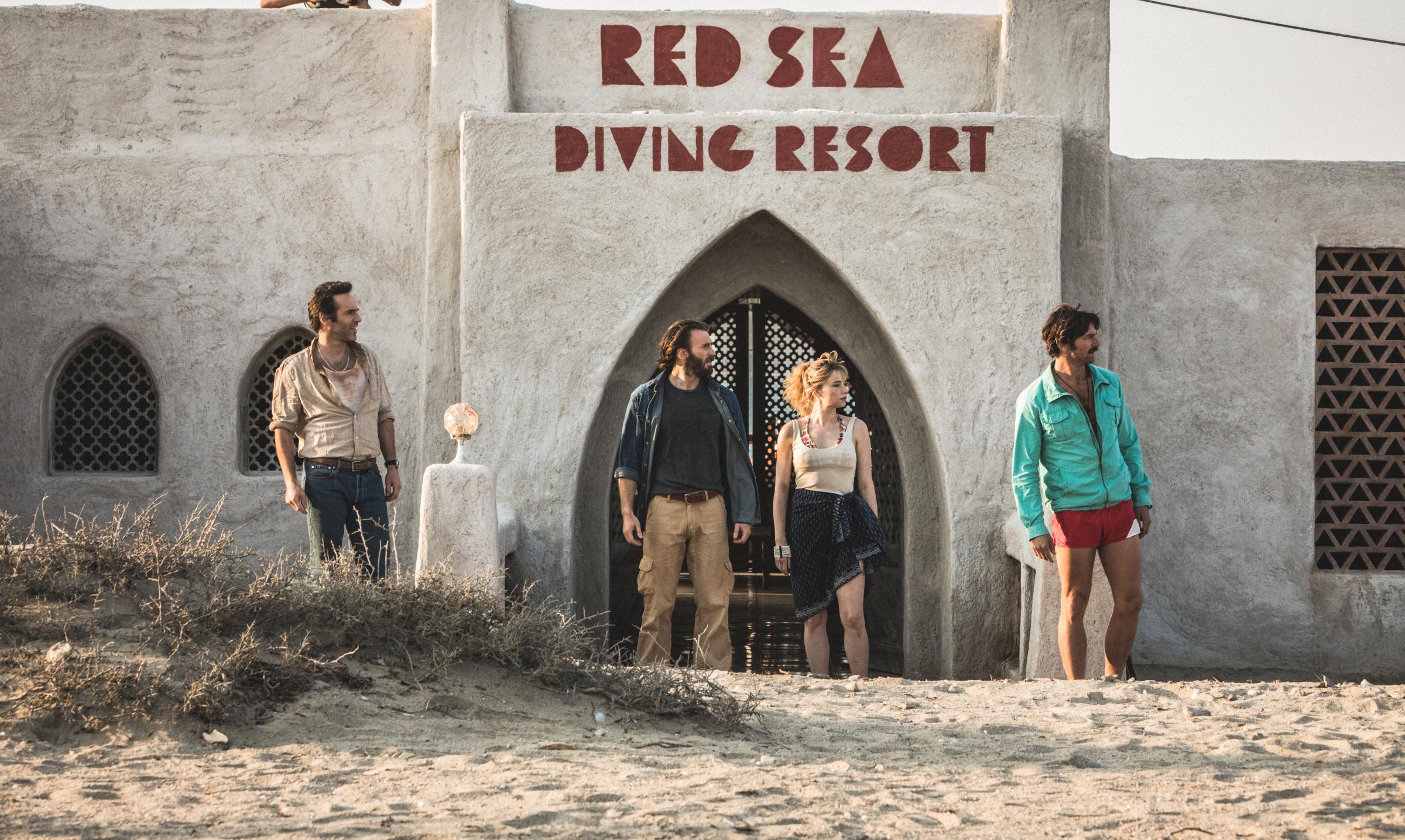Arous Holiday Village seemed like an idyllic vacation destination. In the early 1980s, hundreds of tourists flocked to its sandy white beaches and explored its underwater worlds with beautiful coral reefs. And while its location on the coast of Sudan may not have been an obvious choice for sun-seekers, given the country’s history of conflict and drought, brochures distributed across European travel agencies emphasized the regular flight routes from London, Paris and Rome to Khartoum, as well as the warm temperatures and pleasant sea breezes. But there was much more than met the eye at the popular beach resort, and that story is the inspiration for new Netflix film The Red Sea Diving Resort.
Starring Chris Evans, Michael K. Williams and Haley Bennett, The Red Sea Diving Resort is based on true events, namely the Operation Brothers mission which ran from 1979 to 1984 and saved the lives of thousands of Ethiopian Jews. In reality, and as depicted in the film, an abandoned hotel did serve as the perfect cover for a risky operation smuggling Ethiopian Jewish refugees through the hotel on the East African coast, sending them onwards by boat to safety and new lives in Israel. Official information related to the mission was declassified only in recent years.
Some critics have called out The Red Sea Diving Resort for putting forth a “white-savior” narrative, privileging the roles of the Israeli Mossad agents led by Evans’ character Ari Levinson. Director Gideon Raff said in a statement that the Ethiopian community “were true partners in this operation and they are the real heroes of this story,” noting that it was important to him to cast actors from the Ethiopian community in the film. The movie’s release also comes at a tense moment in Israel, where large-scale protests flared up in early July after the shooting of 18-year-old Solomon Tekah, marking the 11th Ethiopian Israeli killed by police in the past 20 years. Tekah’s death sharpened focus on the grievances of Israel’s 150,000-strong Ethiopian community, members of which have voiced their frustrations against racism and discrimination in the country since the first major waves of immigration that started with these operations in 1980s.
Here’s a closer look back at the history behind the true events that inspired The Red Sea Diving Resort:
Why were Ethiopian Jews fleeing their home country?
The history of Ethiopian Jews is a long and complex one, with many academics unsure of exactly when and how a Jewish population came to be in Ethiopia. While some of their customs are distinct from Hebrew traditions, the community, historically known as Beta Israel, has become a largely accepted part of mainstream Judaism. “It’s a bit shrouded in mystery, but there are reports that a huge community lived in Ethiopia for ages, more than 1,500 years. Some people even speak about millennia,” says Jon Abbink, a professor of governance and politics in Africa, specializing in Ethiopia, at Leiden University in the Netherlands.
In the 1970s and 1980s, a combination of push factors in Ethiopia led to a big exodus of refugees from the Beta Israel community, as depicted in The Red Sea Diving Resort. The Ethiopian revolution in 1974 heightened underlying political tensions in the country, with opponents of the military regime led by Mengistu Haile Mariam facing the threat of arrest or execution. There were also environmental and economic factors, with droughts in 1973 and 1974, and again in the early 1980s, leading to widespread famine and one of the worst humanitarian crises of the 20th century.
Amid the country’s descent into civil war beginning 1974, Ethiopian Jews became more prominent as political revolutionaries, active in rebel struggles against the military regime. Infighting between the differing rebel groups, combined with the instability in the country, led to more and more Beta Israel refugees fleeing Ethiopia via Sudan at the beginning of 1978, according to Abbink. “We saw this conjuncture of political and ecological and economic issues which urged the Beta Israel to leave the country, led by community activists,” he says. As depicted in the beginning of the film, the journey across the deserts of the Horn of Africa to reach refugee camps in Sudan was often dangerous, but a risk judged worth taking by Ethiopian Jews who feared for their lives. One estimate suggests that around 4,000 of the 20,000 Beta Israel people who made the journey from northern Ethiopia to Sudan died en route.

Why were Israeli agents involved in refugee rescue operations?
In The Red Sea Diving Resort, Evans’ character Ari Levinson hatches a bold plan: to renovate an abandoned Italian hotel on the coast of Sudan, eight hours’ drive from the capital of Khartoum, and use it as a cover to smuggle Ethiopian Jews from refugee camps to Israel via boat. Israeli officers initially react with skepticism at the proposal, but decide to entrust Levinson with planning the operation and recruiting fellow Mossad agents from around the world to help him.
While this scene appears to have added a touch of dramatic flair, Mossad agents certainly were instrumental in scouting out possible locations that could act as a cover to transport the refugees to safety, as well as eventually running the real-life resort. But the origins of Operation Brothers were also due in large part to the efforts of activists from the Ethiopian Jewish community. “Initially Israeli authorities were contacted by Ethiopian Beta Israel activists asking if they could help. There definitely was a demand,” says Abbink. One of these activists was Farede Yazazao Aklum, who was the inspiration for Williams’ character. After fleeing his home in Tigray, northern Ethiopia, and walking the grueling 300 miles to Khartoum, Sudan, Aklum wrote a letter that triggered Israeli Prime Minister Menachem Begin to task Mossad agents with the rescue of the Beta Israel.
Earlier in the 1970s, smaller numbers of Ethiopian Jews were transported to safety by plane from Khartoum and welcomed in Israel. Larger Mossad-led operations including Operation Brothers, and the later Operation Moses (1984-1985) and Operation Solomon (1991), were responsible for the arrival of an estimated 90,000 members of the community in Israel by the end of the 1990s. “In the case of the Beta Israel, this was the only example where another country was willing and able to help the people, and adopt the people,” says Abbink. “Many other refugees remained, and still are in Sudan, because no country is really ready to take them in. But the Israeli government made a commitment to take their people in.”
Did an escape mission really happen at a hotel in Sudan?
In 1981, Mossad agents scouted the Sudanese coastline and found 15 beachside villas that had been abandoned a decade earlier. Nestled on the shorelines of the Red Sea and boasting picturesque coral reefs, the resort provided a front for agents to covertly transport Beta Israel refugees to boats that would carry them to Israel. As depicted in the film, the Sudanese International Tourist Corporation did actually believe it was renting the resort out to hotel managers and diving enthusiasts — all of whom were in fact undercover Israeli operatives. Real, unsuspecting tourists, mainly from Europe, came to stay at the resort, attracted by brochures that touted “breathtaking views of the heavens, aflame with millions of stars” and “an abundance of exotic fish” in “exceptionally clear waters.”
“This operation was so fulfilling, because you were saving hundreds of people from a very bad fate,” said Yola Reitman in a video interview for a behind-the-scenes look at the film. Reitman was an Israeli agent responsible for managing the hotel, a role reflected by Haley Bennett’s character in the film. At the time, Abbink was studying the Beta Israel community in Israel, and knew of the operation that was happening at the Arous Holiday Village. “Of course, I kept my mouth shut so as not to endanger anything. It was an extremely delicate mission,” he recalls.

Was the mission successful?
As depicted in the film, the mission spanned years and resulted in the relocation of thousands of Ethiopian Jews to Jerusalem, while agents kept up appearances maintaining and managing the hotel. According to Abbink, around 8,000 Beta Israel individuals escaped to Israel via Sudan with the help of the Israeli resort staff, which made it the largest-scale operation of its time.
As a boy, Daniel Sahalo and his family fled from Ethiopia via Sudan to Israel as part of Operation Moses, which airlifted over 7,000 Ethiopian Jews to Israel in 1984-1985. “There was just a rumor that we needed to get to Sudan and from there we might be able to get help,” he said in a video interview. Sahalo worked as an historical consultant on The Red Sea Diving Resort, saying that the film was important to tell to future generations because “these people risked their lives every day for almost three years.”
“What I hope the audience will think about when they see the film is that there are about 65 million refugees in the world today,” said Raff in a statement. “We seem to be closing the doors in their faces and many of them are losing their lives on their way to a better future. Compassion would be the biggest thing that I hope people will take away.”
Correction, August 1
The original version of this story misstated The Red Sea Diving Resort’s connection to Mossad Exodus: The Daring Undercover Rescue of the Lost Jewish Tribe, by Gad Shimron. The film is not associated with the book.
More Must-Reads from TIME
- Caitlin Clark Is TIME's 2024 Athlete of the Year
- Where Trump 2.0 Will Differ From 1.0
- Is Intermittent Fasting Good or Bad for You?
- The 100 Must-Read Books of 2024
- Column: If Optimism Feels Ridiculous Now, Try Hope
- The Future of Climate Action Is Trade Policy
- FX’s Say Nothing Is the Must-Watch Political Thriller of 2024
- Merle Bombardieri Is Helping People Make the Baby Decision
Contact us at letters@time.com